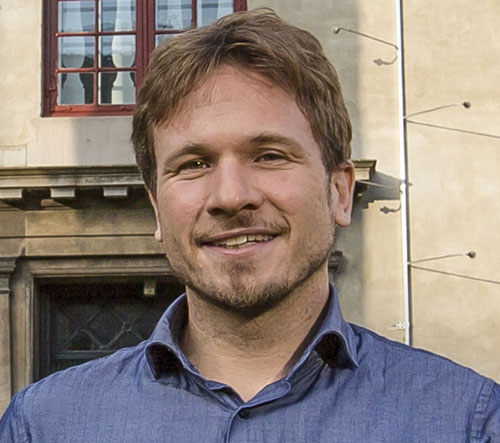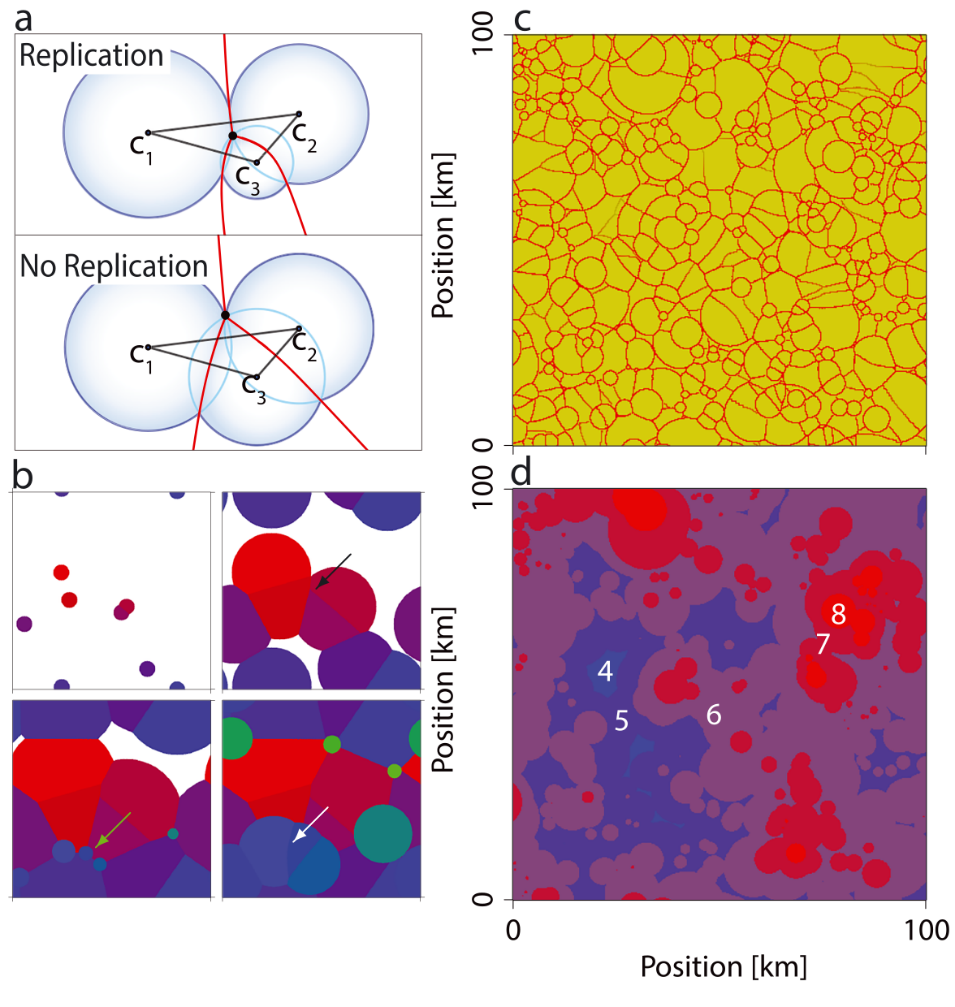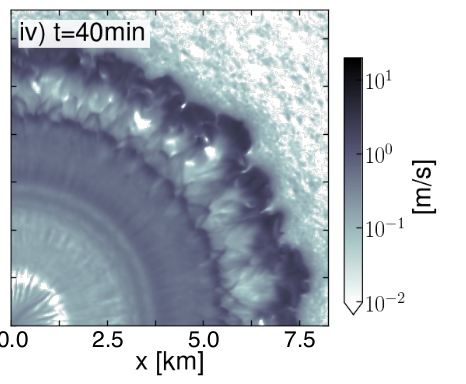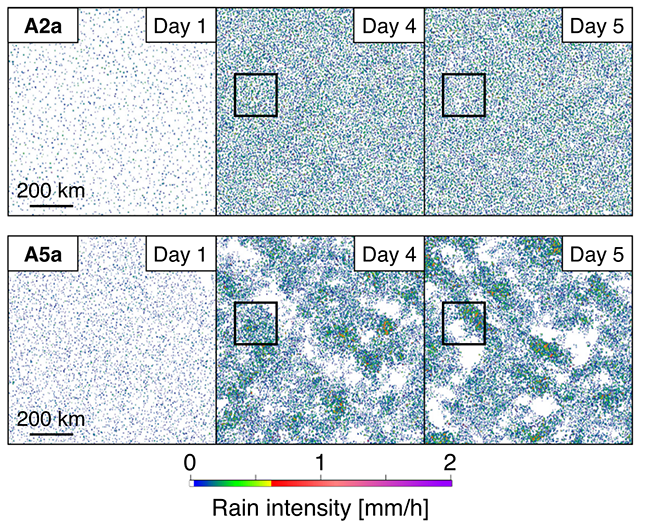he satellite image above shows how mesoscale convective systems (MCS) organize over the African continent and are advected westward by the prevailingwind. Off the coast, tropical cyclones sometimes form and migrate further West and poleward, thereby picking up more moisture under rotation.
Please contact Jan O. Haerter if you are interested in joining the team!

NEWS
New seminar series launched
The ZMT Seminar Series: Beyond Modelling invites talks with a mathematical or computer simulation modelling perspective and is open to a wide audience with an interest in modelling and its application to real-world phenomena.
New Paper on Diurnal Convective Self-Aggregation (May 2022)
Postdoc Gorm Gruner Jensen, together with Romain Fiévet and Jan O. Haerter just published a paper in JAMES, highlighting the importance of the diurnal cycle in enabling persistent atmospheric drying - a form of hysteresis which is sustained under more constant conditions. This result is relevant to the advection of atmospheric disturbances from the tropical continents to oceans, e.g., for the formation of tropical cyclones.
Yahaya Bashiru joins the group as PhD Fellow (April 1st, 2022)
He will be focused on the West African climate and how extreme events affect the coast.
Christiane Sieß starts her MSc Project (April 1st, 2022)
She will be focused on land-atmosphere interactions and how they bring about convective self-organization.
New Paper on Cold Pool Measurements
Irene Kruse, PhD student in the group, just published her first paper. Congrats to her!
Ronja Gronemeyer receives OHB Award for outstanding MSc thesis
In her thesis, "Merge or die: Rain cell dynamics in the absence of cold pools," carried out with Uni Bremen and within the working group Complexity & Climate, Ronja explored how convective raincells gradually cluster in space. Her work has potential future implications for the better understanding of tropical rain events, especially extremes.
Mesoscale cloud organization workshop
Co-organized by Leibniz ZMT in the Netherlands
Abstract submission opens Dec 1, 2021
New article by Nicolas Da Silva on convective extremes:
Significant amplification of instantaneous extreme precipitation with convective self-aggregation
Article in HORIZON - The EU Research & Innovation Magazine -
Cloud shapes and formations impact global warming - but we still don't understand them
RESEARCH FOCUSWe study the self-organization of convective clouds, that is, thunderstorms, using high-resolution computations (e.g., large-eddy simulations), conceptual modeling (see examples below) and observations (such as from satellite and radar data). Convective clouds dominate much of the rainfall and storminess in the tropics, and especially when thunderstorms organize into larger clusters, such as MCSs (> 100 km in diameter), these groups of clouds can produce heavy or extreme rainfall. A particular focus is on the special role played by the coasts.
Over continents, such as tropical Africa, MCS are very common and show typical diurnal, i.e. day-to-night, variations. Over the ocean, the diurnal variation is weaker and cloud organization is more "long-term," with clusters organizing over several days. Dependent on sea surface temperatures and the details of the interaction with the surface, clusters can grow into tropical cyclones - extreme events that heavily impact tropical or sub-tropical coasts.
PRINCIPAL INVESTIGATOR
Jan O. Haerter has a PhD from University of California at Santa Cruz (2007) in theoretical condensed matter physics. He subsequently s pent three years as a postdoc at Max Planck Institute for Meteorology, Hamburg. In 2011, Jan joined the Center for Models of Life, Niels Bohr Institute, Copenhagen, where he worked on a range of complex systems. In 2015, he spent a research visit at the Complexity Lab, University of Barcelona and subsequently returned to the Niels Bohr Institute to build his own research group, Atmospheric Complexity. In 2020, Jan joined the Leibniz Centre for Tropical Marine Rresearch (ZMT), where he is spending his ERC Grant to build the research group Complexity & Climate.
pent three years as a postdoc at Max Planck Institute for Meteorology, Hamburg. In 2011, Jan joined the Center for Models of Life, Niels Bohr Institute, Copenhagen, where he worked on a range of complex systems. In 2015, he spent a research visit at the Complexity Lab, University of Barcelona and subsequently returned to the Niels Bohr Institute to build his own research group, Atmospheric Complexity. In 2020, Jan joined the Leibniz Centre for Tropical Marine Rresearch (ZMT), where he is spending his ERC Grant to build the research group Complexity & Climate.
Through the PI's double affiliation, there is lively collaboration and scientific exchange with the Atmospheric Complexity group at the Niels Bohr Institute, University of Copenhagen.
RECENT RESEARCH HIGHLIGHTS
-
Persistent clustering from temperature oscillations (preprint)
Reference: The diurnal path to persistent convective self-aggregation
We show that persistently clustered rainfall super-structures can emerge over tropical continents, when the surface temperature, and thus the heat entering into the atmosphere, is not constant, but oscillates on a daily basis.
-
Extreme Thunderstorm Precipitation (2021)
Reference: Anthropogenic intensification of short-duration rainfall extremes
At short timescales, the intensity of rainfall from thunderstorms is known to increase at rates beyond the Clausius-Clapeyron rate, as temperatures rise. This recent review article summarizes the state-of-the-art on the question of short-duration extreme events.
-
Simplified models for convective organization (2020)
Reference: Circling in on convective organization
The dynamics of cold pool collisions and replications during a large-eddy simulation is complex, with collisions often giving rise to subsequent convective events, which again can trigger further event, and so forth .... We break down this complex dynamics into simplified models, such as the “circle model” described in the reference above. This model has essentially zero parameters and can nonetheless replicate a big part of the “convective scale increase” found in earlier work on the convective diurnal cycle.

Simplified circle model for convective organization through cold pool collisions. a, Each circle represents the gust front of a convective cold pool. Where three circles meet, a new circle is formed (given that the new circle center lies in the triangle formed by the three previous centers). b, Exemplifying the dynamics of circles spreading and replicating in space. c, gust fronts formed by the circle model after some time, d, cold pool dynamics in terms of “generations” of circles (color coding represents different generations).
-
Cold pool collisions can give “birth” to new convective cells (2020)
Reference: Mechanical forcing of convection by cold pools: collisions and energy scaling
Observations have repeatedly shown that the collision of cold pools can give rise to subsequent convective events - yet such work was mostly anecdotal and include the entire range of real-world effects, such as varying surface conditions, topography, external forcing by large scale wind, etc. We therefore idealize, by imposing simple and symmetrically oriented cold pools (Fig. 2) as dense boundary layer anomalies and allow these to spread under gravity. This enables us to explicitly study how collisions between cold pools affect their propensity at triggering subsequent deep convection. The finding is that collisions lead to larger cloud base mass flux at locations where gust fronts meet - single cold pools have weaker updrafts and their gust front keeps moving, hence distributing moisture rather than focusing it in a small area.

Spreading of a cold pool along the surface. Panels show the cloud base mass flux generated by a single cold pool, the collision of two cold pools and the collision of three cold pools. Analysis shows that the collisions give rise to much more pronounced cloud base mass flux, thus opening for a larger probability of generating new convective events - a replication mechanism is thus encoded.
-
Crowding of thunderstorms leads to runaway heavy rainfall (2020)
Reference: Diurnal self-aggregation
Thunderstorms are fascinating, as they produce spatially rather confined rainfall, which can be quite heavy and cause substantial flooding. Flooding is much more pronounced when single thunderstorm "pillars" join together in space so that a wider area is covered by heavy rainfall events - leading to extremes. Such clusters of thunderstorm events are, therefore, of high scientific interest, yet, it is not well-understood how they form.
Our study shows that under relatively simple conditions, such thunderstorm events emerge spontaneously, that is, without an external driver causing them to develop. All it takes is that the surface temperature repeatedly varies by several degrees Celsius between night and day (see Animation). In this case, clusters of thunderstorms, 180 km across and with a duration of 6 hours, spontaneously develop, leading to heavy rainfall. In contrast, when the temperature varies less between day and night, no such clustering is found - rainfall is modest throughout the simulation domain.

Diurnal self-aggregation. Clustering of convection under the diurnal cycle, mimicking continental conditions (lower panels) compared to reduced diurnal cycle, mimicking oceanic conditions (upper panels).
Haerter, J.O., Meyer, B. & Nissen, S.B. Diurnal self-aggregation. npj Clim Atmos Sci 3, 30 (2020). https://doi.org/10.1038/s41612-020-00132-z






